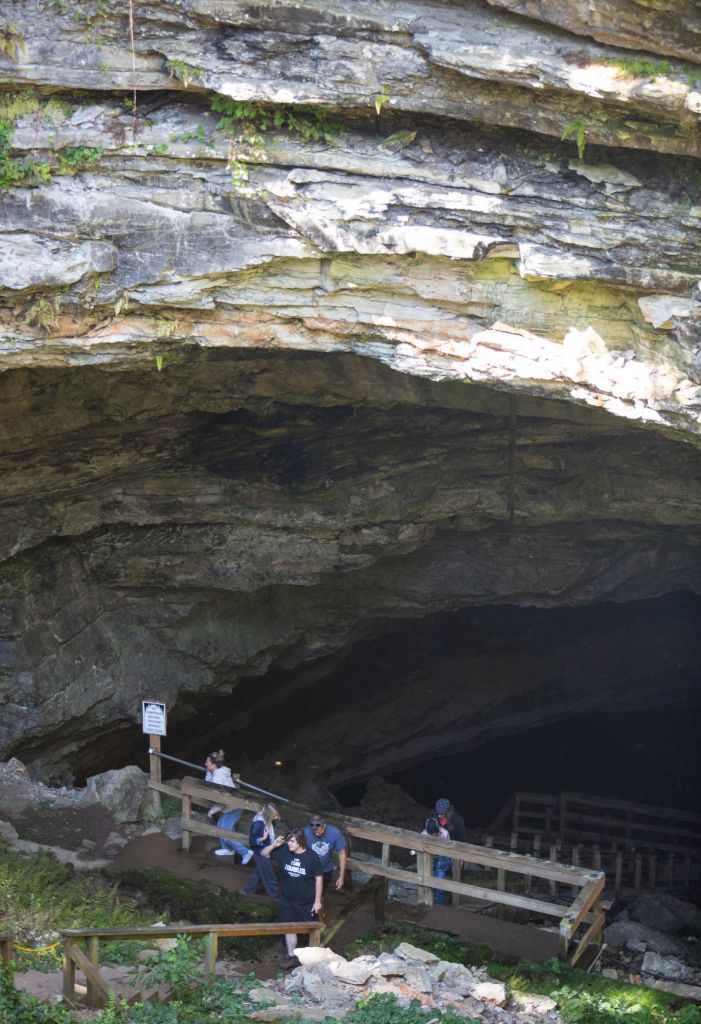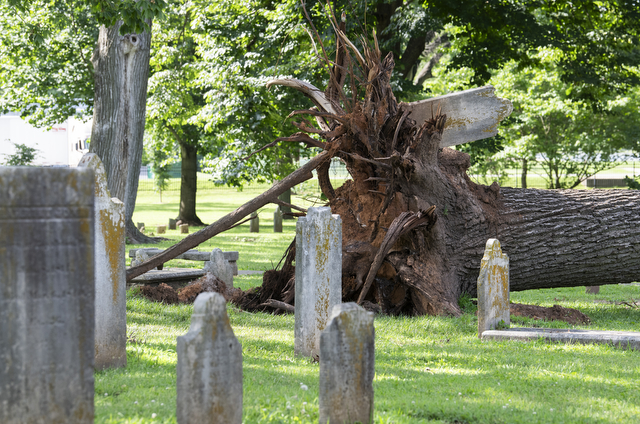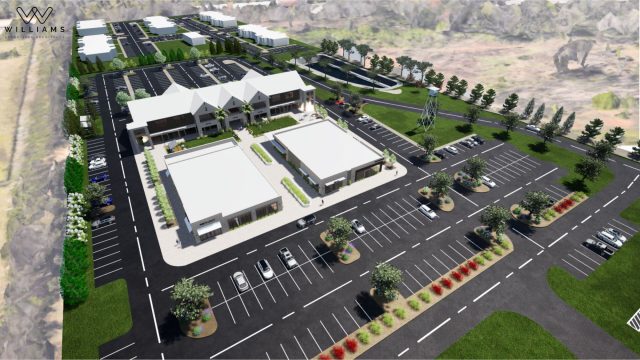Troubled Waters: The battle to save Hidden River Cave, once the ‘worst polluted cave in the U.S.’
Published 11:30 am Sunday, October 2, 2022

- Visitors tour Hidden River Cave in Horse Cave on Friday. The cave battled worsening pollution issues from the 1930s to the late 1980s, much like Lost River Cave in Bowling Green is currently, due to contaminated groundwater running through the cave system. (Grace Ramey)
In the mid-1900s, there was a running joke in Horse Cave. Locals quipped that those heading downtown ought to park on opposite sides of the street each day so the fumes emanating from Hidden River Cave would wear their car’s paint off evenly.
Nowadays, the cave’s entrance can come as a bit of a surprise to passers-by not accustomed to turning a corner onto Main Street and seeing a massive hole in the ground. But from the 1930s to the late 1980s, there were no such shocks. Everyone could smell it coming.
“If you’ve ever left a milk jug in the refrigerator for too long, and then opened it and sniffed it, and it turned sour you know what that smells like,” said David Foster, Hidden River Cave executive director. “Well, we had a whole river full of that.”
The primary culprit was a creamery about a mile upstream. At the time, there was no sewer system in Horse Cave, and no natural surface water close enough to dump sewage in. So waste was pumped into the groundwater instead, which flowed to Hidden River Cave, where the creamery waste quickly began to ferment due to the cave’s lower oxygen levels.
The resulting hydrogen sulfide odor could be smelled “all around town,” especially on a hot summer day.
The worsening pollution eventually halted cave tours in 1943. For nearly a half century afterward, the cave sat fenced in, inhabited only by sewage bacteria and masses of bright red bloodworms writhing on the edge of the cave’s underwater streams. Things would get worse before they got better.
As it turns out, fighting against cave groundwater pollution is an uphill, unpopular battle.
So, what are karst regions?
To understand how Horse Cave got itself into this predicament, an introductory geology lesson is required.
The town lies on karst terrain, a landscape featuring soluble bedrock, like limestone, that is easily eroded by rainwater. Over half of Kentucky lies on bedrock with potential to produce karst terrain, while a quarter already boasts well-developed karst features, according to a Kentucky Geological Survey conducted by the University of Kentucky.
A karst terrain might contain features like caves, sinkholes, sinking streams or closed depressions.
In a pre-sewer era, the thousands upon thousands of sinkholes in the region were “Mother Nature’s way of draining the lands in limestone terrain,” Foster said. “They’re all tied to caves.”
Sinkholes form over thousands of years through erosion as rainfall enters the soil, mixes with carbon dioxide and decaying vegetation to form acidic water that forms cracks in the bedrock that eventually grow into a network of large cavities. The bedrock foundation inevitably collapses in on itself over time, forming a sinkhole. The rocks and soil that collapse into the sinkhole have to go somewhere, and in Horse Cave’s case, that was straight to Hidden River Cave.
Unfortunately, the rocks and soil were joined by untreated sewage waste, and down in the caves, there wasn’t any sunlight to set in motion natural processes like algae growing to eat harmful bacteria.
“Underground, everything just goes bad pretty quickly and stays bad,” Foster said.
Things get worse before they get better
For decades, the cave groundwater was used as Horse Cave’s source of drinking water.
In 1888, Dr. George Thomas bought the cave property and quickly got to work installing systems to pump water and generate hydraulic energy, according to a 1993 National Speleological Society article by biologist Dr. Julian Lewis.
The cave as a source of drinking water waned as wells came into use, but it remained indispensable during droughts. By 1930, signs of trouble had emerged. An oil refinery dump into a sinkhole south of Hidden River Cave ended up tainting its water and leading to several cases of typhoid. A 1932 chlorinator wasn’t enough to fix the issue.
Instead of addressing the root of the problem, Horse Cave found an alternative water source. While cave fish used to be so common that they were caught and given to tourists as souvenirs, by 1943, groundwater pollution had extinguished the biodiversity of the cave. Cave tours were canceled indefinitely.
“The residents of the Horse Cave area literally poisoned their own water source and destroyed the town’s tourist industry,” Lewis wrote.
Hidden River Cave festered for two decades as a glorified landfill before Horse Cave’s first sewage treatment plant was built in 1964.
However, after the plant treated waste, it drained the effluent into a sinkhole and disposal well both connected to Hidden River Cave’s southern branch, according to Lewis. The cave groundwater lacked the assimilation capacity to handle even the treated sewage. Cave City directed its effluent to the eastern branch.
Park City’s untreated sewage also ran to the cave, according to a 1984 New York Times article. After rainfall, the sewage problem would worsen, NPS geologist Dr. Jim Quinlan told the Times.
Bill Austin, the cave owner, reportedly said that when he went to see the other side of the disposal well inside the cave, the creamery waste – up to his chest at some points —blocked the view.
The final straw in the pollution saga was the town’s second factory, a chrome plating plant that came to Horse Cave in 1970 whose heavy metals were toxic enough to kill the microbes intended to filter and break down sewage plant influent before disposal into the cave.
Lewis and Jim Eckstein, University of Louisville biology students, took their first trip to study the cave pollution in 1982.
“What we saw was absolutely sickening,” Lewis wrote. “In the South Branch, thick clusters of bright red ‘bloodworms’ lined the edges of the stream. … Gray strings of sewage bacteria covered the surfaces of submerged breakdown. The stench in the cave was overpowering.”
Lewis did in fact get sick, spending several days in the hospital on what she presumed would be her deathbed after the trip. The following visit, she wore gloves and a face mask.
ACCA answers the call
Bill Austin had been sending out the Bat-Signal for years, but nobody dared answer until 1986.
The American Cave Conservation Association was looking to make a name for itself, and what better way than by turning around what was dubbed one of “the most polluted caves in the United States”?
“We had concluded that one of the biggest conservation problems was lack of public understanding. So if we were going to succeed in conservation efforts, education had to be a major part,” said Tom Aley, groundwater hydrologist. “To do that education we felt that a hands-on approach would be the best method possible, and we thought that meant having something that people could really see.”
It was a gamble, Aley said. The ACCA, made up of scientists, cavers and land managers, wanted to establish a museum next to their chosen cave about groundwater in karst regions.
“It was a risk that the smell would not ever be controlled,” Aley said. “But being able to say, ‘Look how bad it was, yet we can fix these things if we work together on projects’ … We really liked that idea.”
The ACCA team was joined by the Caveland Sanitation Authority, a Louisville engineer named Dave Derrick and Quinlan, who had been secretly working on the problem for a decade, Foster said. Quinlan worked for the National Park Service at Mammoth Cave, and his employers didn’t want him double-dipping outside of the park. However, his expertise in dye-tracing and mapping water systems was invaluable, so Austin discreetly paid him on the side.
“A lot of people thought they knew where the caves went, but nobody really knew,” Foster said.
Together, the team hatched a plan for a regional sewage system that would connect Horse Cave, Park City, Cave City and Mammoth Cave National Park. Instead of discharging effluent into the caves, it would all go into pipelines to Green River, which was a large enough body of water to be able to dilute the effluent to the point where it wouldn’t be problematic.
Half a century after the problem began, Horse Cave had a real roadmap to a solution.
But in many ways, the battle had just begun.
—See the next installment in the Oct. 9 Daily News






